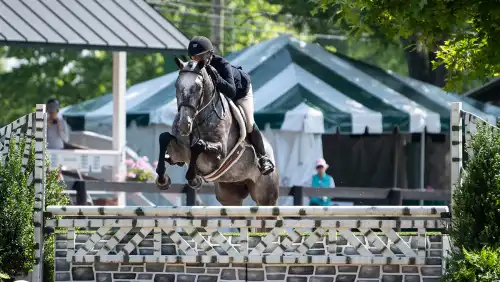Fifty years ago, in the Feb. 15, 1974 issue, the Chronicle published a notice informing readers of the newly revamped pony heights for the three pony divisions. Previously the ponies were divided into ponies under 11.2 hands, between 11.2 and 13 hands, and between 13 and 14.2 hands, but at the January 1974 AHSA Annual Meeting a rule change was approved changing the pony heights to our modern standard. Read on to hear how it happened and their reasoning for the change in the article titled “AHSA Changes Pony Hunter Height Classification” penned by H. M-S A.
A decision to change the hunter pony division’s three sections to 12.2 hands, 13.2 hands and 14.2 hands was reached by the AHSA membership and approved by the Executive Committee at their Annual Meeting, January 12. The old jump heights, at 2’, 2’6” and 3’, will remain the rule only for 1974. When shows choose to offer only the 13.2 and 14.2 sections the jumps will be lowered to 2’ for the 12.2-hand ponies.
Published as a proposed rule change in the AHSA’s December issue of Horse Shows, the proposal stimulated considerable discussion. The prestigious Virginia Horse Shows Association went on record as being opposed to it, but reconsidered to vote in favor of the change at the AHSA meeting. We are advised that widespread recommendations from exhibitors, officials, judges and breeders that the jump heights be raised to 2’6” and 2’9” for the 12.2 and 13.2 sections, or at least 2’3” for the 12.2 sections, will be proposed for 1975. Leading up to the approval were recurring efforts over the years by various people to secure three sections (as the British pony events provide). The current number of ponies (still increasing) has made this logical change more necessary than before. The importance of the hunter pony division has increased in the eyes of show management, so that their old objection to additional changes in jump heights has faded.

Mr. Charles A. Gartrell of Maryland, chairman of the Hunter and Jumper Pony Committee, as well as a breeder of highly successful conformation ponies, said that, with the 11.2-hand section having dwindled to 8-10 entries at the Maryland Pony Show (the biggest U.S. pony show), and with the pressure of numbers in the 14.2-hand section so in need of relief, a study was undertaken by the committee. With the help of Miss Georgine Winslett, Mrs. Henry Hulick and Mrs. T.M. Waller, among others, the height distribution among the arge shows classes was found to list a sufficient percentage of ponies between 12.2 and 13.2 hands to support the rearrangement of the three sections.
This change will exercise profound influence far beyond the simple redistribution of entries. The beneficial consequences begin with those for breeders, allowing them to choose the best matings and no longer being restricted to the production of ponies 13 hands and 14.2 hands, in order to suit the market. With the more equitable 4-inch range per section (one common to most other show ring sections) all sizes now become acceptable.
ADVERTISEMENT
There are a great many 12.2-hand ponies available, this height being the limit for Welsh Section A Ponies which have so dominated the small pony field. More 13.2-hand ponies will emerge, others will be bred expressly. The larger Section B Welsh Pony Fits right into this section, as does the Welsh-Arab cross. The supply of 14.2-hand ponies, more expensive to raise and less plentiful, may feel less pressure.
With the competitors better distributed, the short stirrup classes, with their many new young riders on small ponies, can have more equitable competition. The Maryland Pony Show says it will now reinstate riders competing in open classes. More capable riders will go on, in an easy progression, to the 12.2-hand section, while older riders will find themselves suitable to the top two sections.
The 13.2-hand pony is more apt to be a pony in type than is the half-Thoroughbred 14.2 individual. Its small ears, quality head, good bone, calm attitude and agile way of moving appeals to the buyer as well (as to the judge) quite differently from the more lightly built and more fluid movers making up the 14.2 ranks, so that the two sizes and types are much better suited to compete in separate sections.
The change does seem to offer a better pony world to the whole slate of the rider, owner and breeder, as well as the teacher, judge, show manager and… pony.














